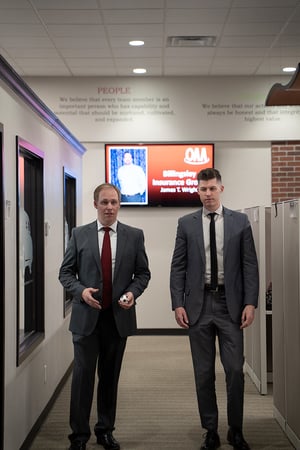How To Create A Business Plan for Your Insurance Agency
12 min read
Topic: Insurance Marketing Insurance Agency Management sales Start an Agency Grow an Agency
“What’s the plan?”
That’s the question my wife and I ask each other every day about 3:00 in the afternoon. We have pretty busy lives with multiple businesses, children, hobbies, and activities to manage. So, probably just like you, we need a plan to get it all done!
If a plan is important for getting a family through the day, how much more important is a plan for an insurance agency with customers to serve, sales to make, companies to satisfy, and employees to manage?
It’s critical.
But who has time to plan with all that going on?
That’s a great and valid question. The other one for the typical Type A insurance business owner is, “Can I get someone else to do it for me?” and, “What’s the minimum planning that will yield the most impact?”
Assuming you have goals to meet and would like every day to be something other than crisis management, let’s take a look at this from a high level.
Getting Started With Your Business Plan
Creating a business plan sounds like work, doesn’t it? It doesn’t have to be. Really, this process is as simple as putting on paper your three-to-five-year goals and general means to achieve them.
For example, this is a super-simple plan template:
-
What are sales going to be each year for 3 years?
-
Net profits? What do you want your balance sheet to look like?
-
What is your ideal business mix? What products and services do you want to sell the most of?
-
What kind of customers do you want to serve? What do they look like demographically (i.e. target market)?
-
How many employees does it take to get this done?
A plan can be a whole lot more complicated, and potentially more valuable, but if you have lots to do, this takes a couple of minutes and it’s a great start.
Consider This Question To Help You Focus:
During lunch with a successful entrepreneur in a business completely unrelated to mine, he asked me this wonderful and powerful question during our meal.
“What are the best opportunities in front of you right now?”
That question really focuses the mind.
I was able to give him an immediate answer and listed for him four priorities for myself and my team. We have more than four opportunities in front of us, so I was interested in my own immediate reaction. You see, like most entrepreneurs and small business owners, I am constantly seeing opportunities and weighing my capabilities and interests.
I answered my friend with four things and a quick note as to why they were important and valuable for our business. It didn’t take a lengthy market analysis or sales forecasting - the question really helped me to focus, prioritize, and verbalize what I want to capitalize on out of many choices. It happened in an instant and will now guide us as we plan for the next year or two - this is the simplest version of an executive summary and it will guide our sales strategy.

Most successful business owners are highly focused people, who don’t pursue every single business idea that runs through their heads. They understand that resources like time, capital, and people are limited. Regardless of their relative level of optimism (an absolute requirement and one of the main keys to success opportunities, but the more successful they become, the more realistic actual opportunities are for them.
So, as they go about building a bigger and bigger future, choosing which opportunities to pursue every year of operation becomes an ever more important task.
As we face the future and the demands of many others who want us to focus on their priorities (opportunities!), choosing which things we will concentrate our efforts on becomes a critical decision for every insurance agent and businessperson.
What about you? What are the best opportunities in front of you right now? Those are the ones to focus your planning.
Let’s Do Some Thinking
Everyone, and every business, is different. I start planning for the next year in the fourth quarter of the year before. Your timing may be different than mine. But you do set aside time to think about the business and plan for the coming year, don’t you? Or do you just let it happen?
This is a great time to be honest with ourselves about this! Let me suggest that if you don’t do annual thinking that you consider it. It’s not hard. It doesn’t have to take a long time but is really important in sustaining growth.
Here are some of the things I think about.
What can we accomplish?
-
What is a revenue goal that is achievable within our current capabilities? As I think about this I ponder the knowns about what the market is doing and which insurance products are more likely to sell.
-
Are rates up or down? Has the weather this year been good or bad?
-
What can we expect from Profit Sharing and PMSF (you do get PMSF, don’t you?)
-
What kind of activity and results are our current marketing efforts producing? How is our market share?
 What is going to happen to overhead next year?
What is going to happen to overhead next year?
-
Do we have rent increases, automation increases, or other overhead cost increases coming?
-
What about employee benefits and payroll?
-
Do we need additional employees to manage the expected normal growth?
-
Do we have a place for them to work? Equipment to use?
-
When do we need them?
Now comes the fun part!
What could we do if we really stretched ourselves?
-
If we are to do that, what else must we do?
-
Do we need to increase marketing investment?
-
Are there any potential investors we should talk to?
-
Hire additional people? Modify compensation strategies?
-
Open another office or expand this one?
-
Add a CRM program?
These and endless other things can and should be considered.
We can’t develop a plan for our business until we spend time thinking about it. Perhaps you do this ad hoc from time to time, but now is the time to organize your thinking and your thoughts and start putting things in written form, even if it’s just a few paragraphs. It’s time to think!
Now, Let’s Do Some Planning
I’ve described the thinking process that I use during the early fall to begin to get ready for a productive, growing period in the coming year. The results of the current year are beginning to take shape and the business environment is more clearly understood. After the thinking process comes planning.
Relax! This doesn’t have to be, nor should it be, complicated or time-consuming for a growing agency. Let me encourage you to make a plan that can be put on one sheet of paper. Two at the most.
If you can’t describe your plans for a year in that space you probably can’t do it all either.
How I Do It
What I do is take the things I’ve uncovered in my thinking process and first use them to create a simple budget:
-
I increase current year results by what I think is the “steady as she goes” growth and expected rate, profit sharing, PMSF and other revenue changes should produce and put that in a month by month spreadsheet.
-
Then I take the overhead thinking I’ve done and put that into the expense ledger. Now I’ve got a simple budget. Is the result of that budget what I want it to be based on my goal setting? Or not? If not, I begin to tweak.
-
Once the budget is all tweaked up I turn to the thinking about the growth goals I want. What does that do to income? What expense increases are required? Those go down on paper and I work on this until I’m satisfied.
This is still not planning! This is budgeting. Now comes the plan:
- What will be required to get the results we are forecasting? (See the next section!)
- When and how will we market?
- What changes to our website, social media, phone program, referral program, etc. do we need to make?
- Do we need more employees, insurance companies, cell phones, or other tools? When and where do we plan to acquire them?
- What else do we need to schedule to do to make the budget work out?
This is planning! See, it’s not hard. It’s really easy when you think about it first!
Now that you’ve done the thinking and planning, next year will be easy. And if you execute on the simple plan you’ve built, tweaking as you go, you’ll get wherever it is you want to go!
More Things to Consider for Your Business Plan
How Much Activity Do You Need to Get the Results You Want?
The “Silver Bullet” to agency growth is activity. One of the natural questions is how much? How much activity will it take to get x results? Really, the question is what do I need to do? What do I need to plan for?
Great questions!
To answer your questions I need a little more information. So, here are my questions to you:
-
What is your growth goal?
-
What is your average sale?
-
What is your closing ratio?
-
How do you get prospects?
Let’s assume I want to add $25,000 in commission revenue to my agency (growth goal). And let’s assume my average sale nets me $450 (note: this is commission, not premium).
Let’s also assume I’m an average salesperson and my closing ratio is 35%. Lastly, let’s assume I get my prospects from a direct mail campaign and my response rate is 1.5% of pieces mailed.
From these assumptions “how much” becomes very clear.
- I need 56 sales! ($25,000 goal divided by $450 average sale).
- I need 160 prospects! (56 sales divided by 35%).
- I need to mail 10,650 mail pieces (160 prospects divided by 1.5%)
Don’t get hung up on whether you think direct mail is the best way to advertise, or whether you think my closing ratio is good or bad. That’s not the point. The point is, if you know some very basic numbers, you can figure out very easily how much activity you need to reach your goal!
Everyone has a different idea about the best way to sell insurance. We all have different goals, talents, resources, and abilities. But we can all achieve our goals with the appropriate amount of activity.
Success is simple. Figure out “how much”. Then go do it!
Pay the Business First
One of our Agency Development team recently met with one of our agencies to work with them on business planning. This is a great thing, because without a plan it is virtually impossible to grow rapidly. This particular agent is my favorite kind of person: a dreamer with big dreams! They are ambitious, hard-working, and highly motivated
In their discussions, the agent and our Development Specialist talked about the agent's desire to hire producers and to build their own office building. Both are potentially great ideas. However, there is a small problem: money.
Our agent owner didn't have any…
When we start our businesses, we entrepreneurs usually need every nickel we can find, right? Every dollar that isn't nailed down often finds its way into gasoline, rent, or shoes for the kids. This is normal. But as the business begins to prosper there is a choice to be made: buy nicer stuff, or feed the business.

We often see agencies with little or no working capital, and without working capital, you simply can't expand, because you can't fund a producer. What bank is going to lend you money on a building when you haven't got any? None. Those days are gone forever.
My partner and I started our agency in 1996, and we didn't take a profit out of the business - not even to pay taxes - until 2003! We were reinvesting all our money in the business.
This is what you must do if you want to keep growing. That doesn't mean you can't take money to improve your family's situation - you can. Do that by increasing your salary over time.
But if you want to keep growing, give the business a raise before you give yourself one.
Our method was to decide each year what the business was going to make in net profits. Until that number was satisfied we didn't get paid and we didn't get a raise either. This method allowed the business to have the money - its lifeblood! - that it needed to keep expanding.
Look around at the successful people you know. The businesses you admire. Very few of them got where they are except by following this little principle:
Pay The Business First!
Make Sure Your Hours Match Your Business Plan
The world is changing. Technology is taking customers away from us. The new world demands a higher level of service and availability from anyone who wants to sell anything.
If, as an independent agent, personal service is the competitive advantage that will help you reach your goals, why aren’t you open more?
I was at the office on a Saturday morning, and I received a nice note from one of our new members about one of our great team members (thanks Natalie!). I fired off a quick “thank you” to the member and said, “Glad to see another entrepreneur working on a Saturday!”
What was interesting was his response, which I quote verbatim:
“Yep. Many can only come in on Saturday. Plus set up apt to sign two Travelers app issued via Access Plus. And doing an auto and home app for Safeco.”
Why was he working on a Saturday?
Because that was the only time prospects and customers can come to see him.
It seems obvious that anyone trying to sell anything would go where the customers are when they are there.
So, why are almost all insurance agencies only open Monday through Friday from 8:00 am to 5:00 pm? By now, even banks have figured out for a couple of decades now that they need to be open past 5 o’clock and be open on Saturday.
Mom and Pop businesses all across America have wrung their hands while they went bankrupt when Walmart came to town. They complained they couldn’t compete on price.
I think it’s much more than that. They refused to compete on service. They weren’t there when the customer needed them.
When will insurance agencies get the message? Before for or after bankruptcy?
Build Your Business Plan for the Long Term
“You must prepare for the future if you want one.”
Plant acorns.
Tyler Asher, President of Safeco Insurance Company, made this headline statement in a speech to an SIAA semi-annual meeting in Boston. His comment was made in the context of a list of things his company is working on to sustain their growth and prepare for a future insurance market, much different from today’s.

If you just take the statement at face value it makes a lot of sense, doesn’t it? Of course, we must all prepare for a bigger future if we want one, and oak is a great symbol of strength and stability. I was immediately captivated by the idea.
But, where the analogy breaks down for me is that it takes a long time to grow oak trees, and the future is coming upon us with breathtaking speed. Do we really have time to grow oak trees?
Then I thought again about a Jeff Bezos quote I wrote about where he says he is more concerned about what stays the same in the next 10 years than about what changes.
I’ve decided that it’s the intersection of Asher and Bezos where we, as independent agency owners, need to focus.
For example, it’s estimated that 60% of the employees in our industry will retire in the next seven years, and if you believe “Outliers” author, Malcolm Gladwell, it takes at least five years (10,000 hours) to train an expert in anything.
I believe, channeling Bezos, that customer service and person-to-person selling will be as important to agency success in the future as it is now. So, how are we going to replace the oak trees (people) in our industry fast enough to secure our future?
I don’t have an answer. But, it’s an incredibly important question for anyone who plans to continue to make this industry their career in the decade ahead.
In our organization, we are creating a streamlined training curriculum, coupled with third party courses and old fashioned apprenticeship, to meet our needs for new blood. Frankly, it’s expensive to do this. But the only other options are to hire other’s problems (which is getting harder and more expensive to do) or go out of business.
The need to invest in new people comes while commission compression and new competition (in the form of online sellers) are beginning to stress some agency income statements. As Tyler Asher points out, you must prepare for the future if you want one.
Viewed in this way, spending on new employees is an investment, not a cost, and the promise of the future is a profitable business built for the long term.
Tony Caldwell
Tony Caldwell is a modern “renaissance man,” who is not only immensely successful in the field of insurance, but is also a writer, children’s advocate, mentor and even a licensed pilot.
Always keen on helping others make their dreams come true, Tony and his team have helped independent agents grow into more than 250 independent agencies. This has made OAA the number one ranked Strategic Master Agency of SIAA for the last 5 years, and one of Oklahoma's 25 Best Companies to Work for.
Tony loves to share his knowledge, insight and wisdom through his bestselling books as well as in free mediums including podcasts and blogs.
Tony and his family are members of Crossings Community Church, and he is very active in community initiatives: he’s chairman of It’s My Community Initiative, Inc., a nonprofit working with disadvantaged people in Oklahoma City; and chairman of the Oklahoma Board of Juvenile Affairs., and he has served through many other organizations including the Salvation Army, Last Frontier Council of the Boy Scouts of America, and the Rotary Club.
In his spare time, Tony enjoys time with his family. He’s also an active outdoorsman and instrument-rated commercial pilot.
Recent Posts
Insurance Marketing
How to Find Insurance Agencies for Sale
Recently, one of my OAA members came to see me for advice on buying an insurance agency. His first...
Insurance Marketing
Tips to Increase Your Independent Insurance ...
Most agents, in my experience, focus on growing their agency's top line - we're always thinking...


